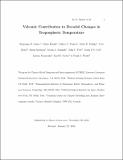| dc.contributor.author | Santer, Benjamin D. | |
| dc.contributor.author | Painter, Jeffrey F. | |
| dc.contributor.author | Zelinka, Mark D. | |
| dc.contributor.author | Mears, Carl A. | |
| dc.contributor.author | Solomon, Susan | |
| dc.contributor.author | Schmidt, Gavin A. | |
| dc.contributor.author | Fyfe, John C. | |
| dc.contributor.author | Cole, Jason N. S. | |
| dc.contributor.author | Nazarenko, Larissa | |
| dc.contributor.author | Taylor, Karl E. | |
| dc.contributor.author | Wentz, Frank J. | |
| dc.contributor.author | Bonfils, Celine | |
| dc.date.accessioned | 2014-08-26T14:24:58Z | |
| dc.date.available | 2014-08-26T14:24:58Z | |
| dc.date.issued | 2014-02 | |
| dc.date.submitted | 2013-11 | |
| dc.identifier.issn | 1752-0894 | |
| dc.identifier.issn | 1752-0908 | |
| dc.identifier.uri | http://hdl.handle.net/1721.1/89054 | |
| dc.description.abstract | Despite continued growth in atmospheric levels of greenhouse gases, global mean surface and tropospheric temperatures have shown slower warming since 1998 than previously. Possible explanations for the slow-down include internal climate variability, external cooling influences and observational errors. Several recent modelling studies have examined the contribution of early twenty-first-century volcanic eruptions to the muted surface warming. Here we present a detailed analysis of the impact of recent volcanic forcing on tropospheric temperature, based on observations as well as climate model simulations. We identify statistically significant correlations between observations of stratospheric aerosol optical depth and satellite-based estimates of both tropospheric temperature and short-wave fluxes at the top of the atmosphere. We show that climate model simulations without the effects of early twenty-first-century volcanic eruptions overestimate the tropospheric warming observed since 1998. In two simulations with more realistic volcanic influences following the 1991 Pinatubo eruption, differences between simulated and observed tropospheric temperature trends over the period 1998 to 2012 are up to 15% smaller, with large uncertainties in the magnitude of the effect. To reduce these uncertainties, better observations of eruption-specific properties of volcanic aerosols are needed, as well as improved representation of these eruption-specific properties in climate model simulations. | en_US |
| dc.language.iso | en_US | |
| dc.publisher | Nature Publishing Group | en_US |
| dc.relation.isversionof | http://dx.doi.org/10.1038/ngeo2098 | en_US |
| dc.rights | Article is made available in accordance with the publisher's policy and may be subject to US copyright law. Please refer to the publisher's site for terms of use. | en_US |
| dc.source | Prof. Solomon via Chris Sherratt | en_US |
| dc.title | Volcanic contribution to decadal changes in tropospheric temperature | en_US |
| dc.type | Article | en_US |
| dc.identifier.citation | Santer, Benjamin D., Céline Bonfils, Jeffrey F. Painter, Mark D. Zelinka, Carl Mears, Susan Solomon, Gavin A. Schmidt, et al. “Volcanic Contribution to Decadal Changes in Tropospheric Temperature.” Nature Geoscience 7, no. 3 (February 23, 2014): 185–189. | en_US |
| dc.contributor.department | Massachusetts Institute of Technology. Department of Earth, Atmospheric, and Planetary Sciences | en_US |
| dc.contributor.approver | Solomon, Susan | en_US |
| dc.contributor.mitauthor | Solomon, Susan | en_US |
| dc.relation.journal | Nature Geoscience | en_US |
| dc.eprint.version | Author's final manuscript | en_US |
| dc.type.uri | http://purl.org/eprint/type/JournalArticle | en_US |
| eprint.status | http://purl.org/eprint/status/PeerReviewed | en_US |
| dspace.orderedauthors | Santer, Benjamin D.; Bonfils, Celine; Painter, Jeffrey F.; Zelinka, Mark D.; Mears, Carl; Solomon, Susan; Schmidt, Gavin A.; Fyfe, John C.; Cole, Jason N. S.; Nazarenko, Larissa; Taylor, Karl E.; Wentz, Frank J. | en_US |
| dc.identifier.orcid | https://orcid.org/0000-0002-2020-7581 | |
| mit.license | PUBLISHER_POLICY | en_US |
| mit.metadata.status | Complete | |
